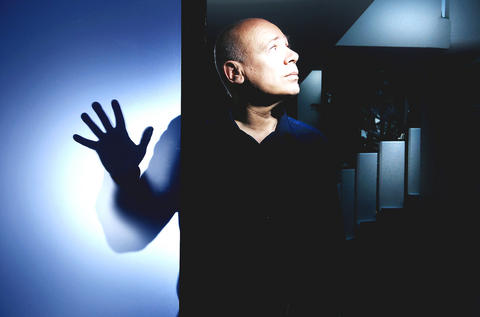On a cold day in January, Dan Stoicescu, a millionaire living in Switzerland, became the second person in the world to buy the full sequence of his own genetic code.
He is also among a relatively small group of individuals who could afford the US$350,000 price tag.
Stoicescu is the first customer of Knome, a company based in Cambridge, Massachusetts, that has promised to parse his genetic blueprint by spring. A Chinese executive has signed on for the same service with Knome's partner, the Beijing Genomics Institute, the company said.

PHOTO: NY TIMES NEWS SERVICE
Scientists have so far unraveled only a handful of complete human genomes, all financed by governments, foundations and corporations in the name of medical research. But as the cost of genome sequencing goes from stratospheric to merely very expensive, it is piquing the interest of a new clientele.
"I'd rather spend my money on my genome than a Bentley or an airplane," said Stoicescu, 56, a biotechnology entrepreneur who retired two years ago after selling his company. He says he will check discoveries about genetic disease risk against his genome sequence daily, "like a stock portfolio."
But while money may buy a full readout of the 6 billion chemical units in an individual's genome, biologists say the super-rich will have to wait like everyone else to learn how the small variations in their sequence influence appearance, behavior, abilities, disease susceptibility and other traits.
"I was in someone's Bentley once - nice car," said James Watson, the co-discoverer of the structure of DNA, whose genome was sequenced last year by a company that donated the US$1.5 million in costs to demonstrate its technology. "Would I rather have my genome sequenced or have a Bentley? Uh, toss up."
He would probably pick the genome, Watson said, because it could reveal a disease-risk gene that one had passed on to one's children, though in his case, it did not. What is needed, he said, is a "Chevrolet genome" that is affordable for everyone.
Biologists have mixed feelings about the emergence of the genome as a luxury item. Some worry that what they have dubbed "genomic elitism" could sour the public on genetic research that has long promised better, individualized health care for all. But others see the boutique genome as something like a US$20 million tourist voyage to space - a necessary rite of passage for technology that may soon be within the grasp of the rest of us.
"We certainly don't want a world where there's a great imbalance of access to comprehensive genetic tests," said Richard Gibbs, director of the human genome sequencing center at Baylor College of Medicine. "But to the extent that this can be seen as an idiosyncratic exercise of curious individuals who can afford it, it could be quite a positive phenomenon."
It was the stream of offers from wealthy individuals to pay the Harvard laboratory of George Church for their personal genome sequences that led Church to co-found Knome last year (most people pronounce it "nome," though he prefers "know-me").
"It was distracting for an academic lab," Church said. "But it made me think it could be a business."
Scientists say they need tens of thousands of genome sequences to be made publicly available to begin to make sense of human variation.
Knome, however, expects many of its customers to insist on keeping their dearly bought genomes private, and provides a decentralized data storage system for that purpose.
Stoicescu said he worried about being seen as self-indulgent (though he donates much more each year to philanthropic causes), egotistical (for obvious reasons) or stupid (the cost of the technology, he knows, is dropping so fast that he would have certainly paid much less by waiting a few months).
But he agreed to be identified to help persuade others to participate. With only four complete human genome sequences announced by scientists around the world - along with the Human Genome Project, which finished assembling a genome drawn from several individuals at a cost of about US$300 million in 2003 - each new one stands to add considerably to the collective knowledge.
"I view it as a kind of sponsorship," he said. "In a way you can also be part of this adventure, which I believe is going to change a lot of things."
Stoicescu, who has a PhD in medicinal chemistry, was born in Romania and lived in the US in the early 1990s before founding Sindan, an oncology products company that he ran for 15 years. Now living with his wife and 12-year-old son in a village outside Geneva, he describes himself as a "transhumanist" who believes that life can be extended through nanotechnology and artificial intelligence, as well as diet and lifestyle adaptations. His genome sequence, he reasons, might give him a better indication of just what those should be. Last fall, Stoicescu paid US$1,000 to get a glimpse of his genetic code from deCODE Genetics. That service, and a similar one offered by 23andMe, looks at close to a million nucleotides on the human genome where DNA is known to differ among people.
But Stoicescu was intrigued by the idea of a more complete picture. "It is only a part of the truth," he said. "Having the full sequence decoded you can be closer to reality."
How close is a matter of much debate. Knome is using a technology that reads the genome in short fragments that can be tricky to assemble. All of the existing sequencing methods have a margin of error, and the fledgling industry has no agreed-on quality standards.
Knome is not the only firm in the private genome business. Illumina, a sequencing firm in San Diego, plans to sell whole genome sequencing to the "rich and famous market" this year, said its chief executive, Jay Flatley. If competition drives prices down, the personal genome may quickly lose its exclusivity. The nonprofit X Prize Foundation is offering US$10 million to the first group to sequence 100 human genomes in 10 days, for US$10,000 or less per genome. The federal government is supporting technology development with an eye to a US$1,000 genome in the next decade.
But for now, Knome's prospective customers are decidedly high-end. The company has been approached by hedge fund managers, Hollywood executives and an individual from the Middle East who could be contacted only through a third party, said Jorge Conde, Knome's chief executive.

Last week the State Department made several small changes to its Web information on Taiwan. First, it removed a statement saying that the US “does not support Taiwan independence.” The current statement now reads: “We oppose any unilateral changes to the status quo from either side. We expect cross-strait differences to be resolved by peaceful means, free from coercion, in a manner acceptable to the people on both sides of the Strait.” In 2022 the administration of Joe Biden also removed that verbiage, but after a month of pressure from the People’s Republic of China (PRC), reinstated it. The American

Chinese Nationalist Party (KMT) legislative caucus convener Fu Kun-chi (傅?萁) and some in the deep blue camp seem determined to ensure many of the recall campaigns against their lawmakers succeed. Widely known as the “King of Hualien,” Fu also appears to have become the king of the KMT. In theory, Legislative Speaker Han Kuo-yu (韓國瑜) outranks him, but Han is supposed to be even-handed in negotiations between party caucuses — the Democratic Progressive Party (DPP) says he is not — and Fu has been outright ignoring Han. Party Chairman Eric Chu (朱立倫) isn’t taking the lead on anything while Fu

There is a Chinese Communist Party (CCP) plot to put millions at the mercy of the CCP using just released AI technology. This isn’t being overly dramatic. The speed at which AI is improving is exponential as AI improves itself, and we are unprepared for this because we have never experienced anything like this before. For example, a few months ago music videos made on home computers began appearing with AI-generated people and scenes in them that were pretty impressive, but the people would sprout extra arms and fingers, food would inexplicably fly off plates into mouths and text on

Feb 24 to March 2 It’s said that the entire nation came to a standstill every time The Scholar Swordsman (雲州大儒俠) appeared on television. Children skipped school, farmers left the fields and workers went home to watch their hero Shih Yen-wen (史艷文) rid the world of evil in the 30-minute daily glove puppetry show. Even those who didn’t speak Hoklo (commonly known as Taiwanese) were hooked. Running from March 2, 1970 until the government banned it in 1974, the show made Shih a household name and breathed new life into the faltering traditional puppetry industry. It wasn’t the first